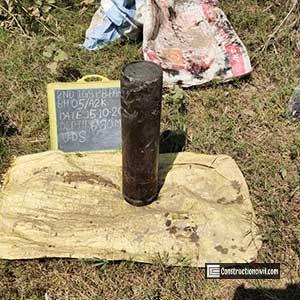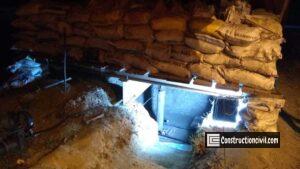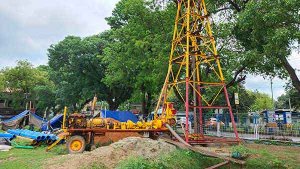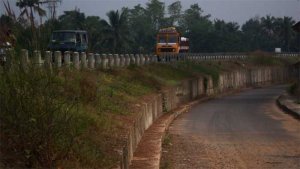The field and laboratory investigations needed to obtain the required soil data for proper design and successful construction of structure at the site are collectively known as the methods of soil exploration.
The selection of the foundation and its depth, bearing capacity, and settlement analysis depend very much upon the several engineering properties of the foundation soils. With the help of different methods of soil exploration, we can collect and analyse the soil data after laboratory tests.
The primary purposes of soil exploration:
- To determine the nature of the deposits of soil.
- To determine the depth and thickness of various soil strata and their extent in the horizontal direction.
- To determine the location of the groundwater table(G.W.T).
- Collecting soil and rock samples from different strata and determining the engineering properties of the soil and rock strata that affect the structure’s performance.
- To determine the in-situ properties by conducting field tests.
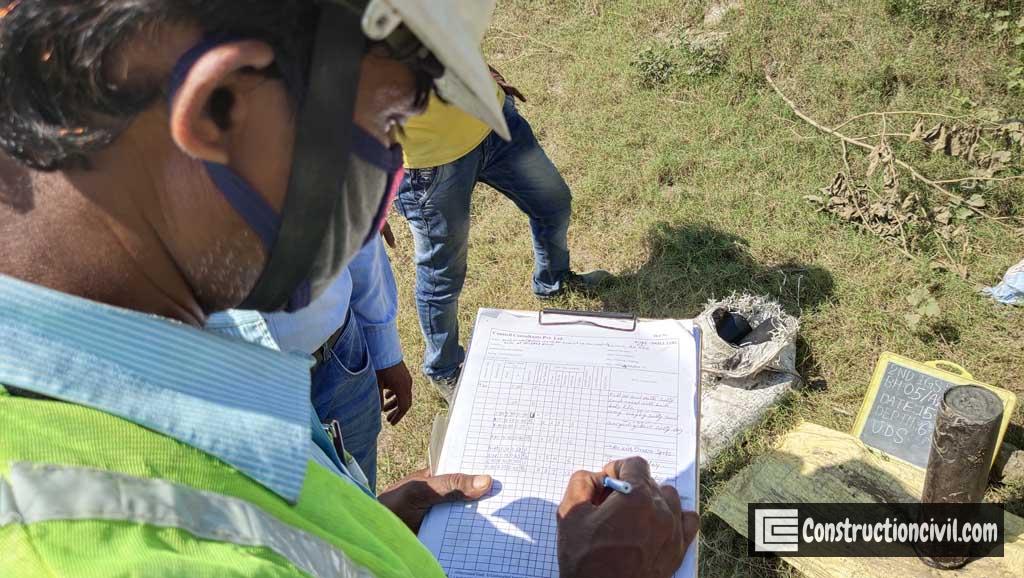
Also, Read: SPT Test for Soil Procedure, Refusal Conditions & Correction
Required data for Engineering Soil properties:
- Soil profile:
- Layer thickness and soil identification
- Index properties:
- Water content, Atterberg limits, etc.
- Strength and compressibility characteristics
- Others (c.g., water table depth)
First Stage of Site Investigation:
A site investigation is a process of collecting information, appraisal of data, and assessing & reporting. Without soil exploration for construction, it is impossible to know the risks in the ground beneath. The first stage of site investigation required the following data, if available.
- Aerial photographs
- Topographical maps
- Existing site investigation reports(for nearby sites)
Also, Read: Geotechnical Investigation Objectives and Guidelines
Methods for soil exploration :
There are three main methods available for soil exploration, which are as follows.
- Direct methods of soil exploration:
- Test pits, trial pits or trenches
- Semi-direct methods of soil exploration:
- Boring
- Soil exploration – indirect method:
- Soundings or penetration tests and geophysical methods
Direct Methods of Soil Exploration -Test Pits:
Test pits are excavated holes which help the Geotechnical Engineer to ensure ground conditions are suitable for the foundation of the proposed structure. The average depth of test pits varies from 3-15 feet deep depending upon the soil condition, allowing geotechnical engineers to assess soil composition before any activity.
- Test pits or trenches are an open type or accessible soil exploratory system.
- Soils can be examined in their natural condition.
- Sampling procedures: can easily collect the underlying soil samples and be used for finding strength and other engineering properties through relevant laboratory tests.
- Test pits are considered fit only for small depths up to 3m; the cost of investigation increases quickly with the pit’s depth.
- For greater depths, parallel supports or excavation bracing will be needed.
- Test pits are typically made only to improve other methods or minor structures.
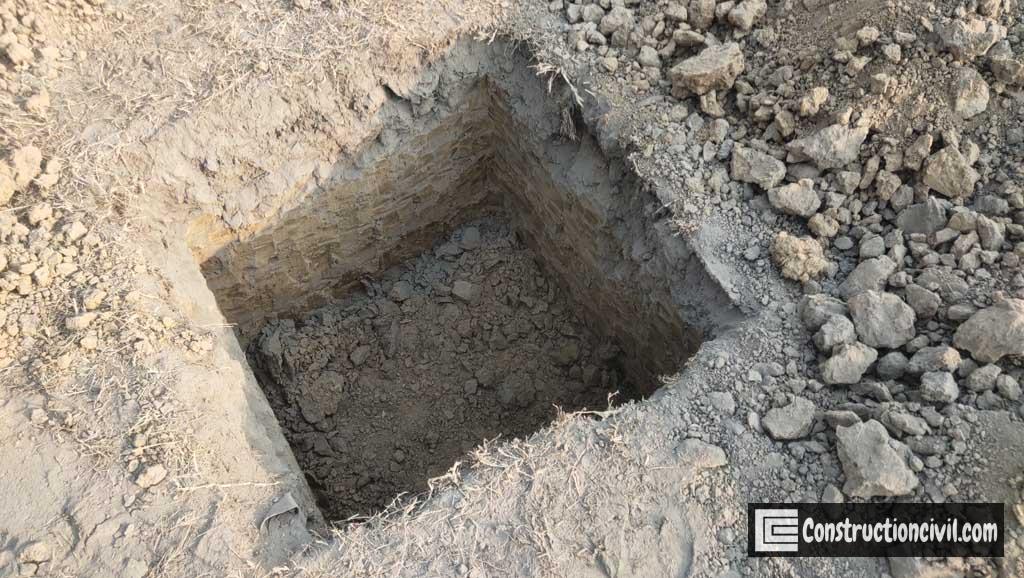
Also, Read: Soil Reinforcement Methods – Advantages and limitations
Semi-Direct methods of Soil Exploration – Boring :
Making or drilling boreholes into the ground with an outlook to obtaining soil or rock samples from particularised or known depths is known as boring.
The Spacing and depth of Borings:
Spacing of Boring:
- Depending on the type of project, spacings of boring may be varied, which are given below.
| SL No | Construction Details | Spacing (Meter) |
| 1 | Multistorey buildings | 10-30 |
| 2 | One-story industrial plants | 20-60 |
| 3 | Highways | 250-500 |
| 4 | Residential subdivision | 250-500 |
| 5 | Dams and dykes | 40-80 |
Also, Read: Vibroflotation, Blasting & Dynamic Compaction – Ground Improvement
Depth of Borings:
- The minimum Depth of Boring (according to ASCE, 1972) for a building project with a breadth of 30.5 m (100 ft) will be as under.
| SL No | Construction Details | Minimum Depth of Boring (Meter) |
| 1 | Single storey | 3.50 |
| 2 | Two storeys | 6.00 |
| 3 | Three storeys | 10.0 |
| 4 | Four storeys | 16.0 |
| 5 | Five storeys | 24.0 |
- Depth of Borings (according to 1IS 1892-1979) for different types of foundations will be as under.
- For isolated spread footing or raft foundation, the boring depth should be one and half times the width(B) of the foundation.
- Boring depth adjacent footings with precise spacing less than twice the width should be one and half times the length (L) of footing.
- For pile foundation and well foundation to a depth of one and half times the width of structure from the founding level(toe of pile or bottom of bearing well).
- In the case of a road cut, the boring depth should be equal to the base width of the cut.
- For road filling, it will be two meters below ground level or equal to the height of the fill, whichever.
Soil Sampling and Laboratory Test:
Types of soil samples received after performing different types of soil Exploration Methods are as follows.
Disturbed Soil sample:
A disturbed sample is that in which the natural structure of the soil gets modified party or entirely during sampling. Disturbed but representative samples can be used for the following tests.
- Grain-size analysis
- Determination of liquid and plastic limits
- The specific gravity of soil solids
- Organic content determination
- Soil classification
Undisturbed Soil Sample:
An undisturbed sample is that in which the natural structure and other physical properties of soil remain preserved. Undisturbed samples can be used for the following tests.
- Consolidation test
- Hydraulic conductivity test
- Shear strength test
- Required for triaxial consolidation tests in the lab.
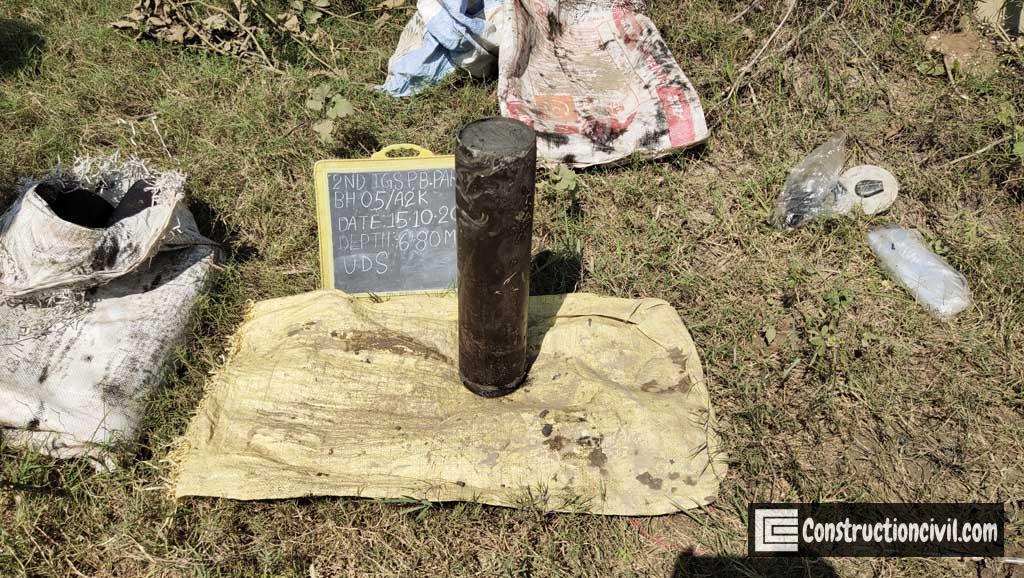
Also, Read: Vertical Pile Load Test Procedure – Kentledge Method
Degree of disturbance:
Always good quality samples are necessary to determine the actual Engineering property of soil.
- We should remember that a thicker wall sampler causes more significant disturbance.
- Take of good care is essential during transportation and handling,
- The recovery ratio can estimate the degree of disturbance of cohesive soil or rock sample. The recovery ratio is equal to the actual length of the recovered sample divided by the theoretical length of the recovered sample.
- The recovery ratio <1 indicates that the soil is compressed
- The recovery ratio >1 indicates that the sol has swelled.
Types of Samplers Used in Different Methods of Soil Exploration:
The primary tool used for collecting undisturbed soil samples in different Methods of Soil Explorationbfrom test pits or boreholes at the specified depth is known as a soil sampler. Based on the area ratio, soil samplers are as follows.
- Thick wall samplers – Split Spoon sampler: Samplers having an area ratio of more than 10% are known as thick-wall samplers.
- A drive shoe attached to the deeper end works as the cutting edge. A sample cap may be screwed at the highest end of the split Spoon.
- The spoon sampler’s regular size is 35 mm inner and 50.80 mm outer diameter.
- The sampler is dropped to the bottom of the borehole by connecting it to the drill rod. The sampler is then pushed by forcing it into the soil by blows from a hammer.
- The sampler arrangement is then removed from the hole, and the cutting edge and coupling at the upper end are unscrewed. The two halves of the barrel are departed, and the sample is thus revealed.
- Samples are generally taken at intervals of about 1.53m (5ft)
- When the material encountered in the field is sand (particularly fine sand below the water table), a device known as a spring core catcher is installed inside the split spoon.
- Thin Wall Sampler: Thin wall samplers are those where the area ratio is less than or equal to 10%.
- A thin Wall Sampler is commonly used to obtain undisturbed clayey samples of 50.80mm and 76.30 mm outside diameter.
- A sampler with a 50.8 mm outside diameter has an inside diameter of about 47.63 mm, and the area ratio is 13.75%.
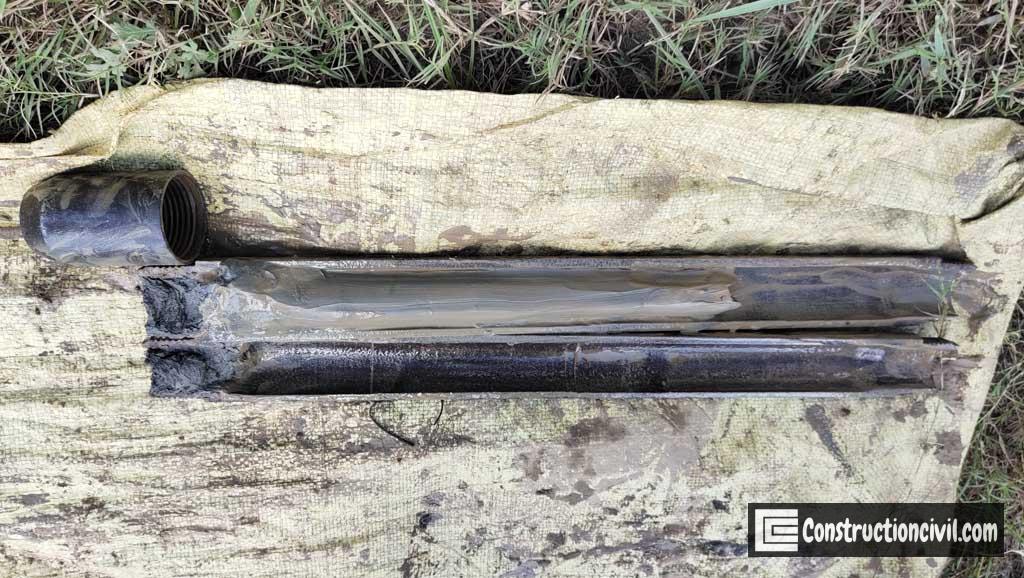
Also, Read: Lateral Load Test Pile – General Arrangement & Procedure
Types of Semi-Direct methods of Soil Exploration – Boring:
The conventional methods of soil exploration for advancing boreholes are as follows.
- Auger boring method of soil exploration
- Wash boring method of soil exploration
- Rotary drilling method of soil exploration
- Percussion drilling method of soil exploration
Auger boring Method of Soil Exploration:
Auger borings are cheap and straightforward methods of soil exploration. In the case of auger boring, vertical holes are progressed with the help of rotating the auger cross arm and pushing it into the soil. When the auger is filled with the soil sample, it is removed, and the process is repeated. The sample collected from the auger is examined.
- The soil auger is useful for developing a borehole inside the ground.
- Augers may be hand-operated or power-driven; the first one is used for comparatively small depths (less than 3 to 5 m), while the second one is used for greater depths (up to 60 to 70 m in case of continuous-flight augers)
- The soil auger is driven by rotating it while pressing it into the soil.
- When the auger gets filled with soil, it is removed, and the soil sample is collected.
- The soil samples collected from this type of borings are very disturbed in nature.
- Augur boring is possible in the case of partially saturated sands, silts and medium to stiff cohesive soils.
- The above soil exploration method is not preferable below the groundwater table.
Shell and auger:
- Shell and auger methods of soil exploration are widely used in India in different construction projects.
- The sand bailer or shell is a heavy-duty pipe with a cutting edge.
- The shell is raised and let fall into a hole. The soil is cut and enters the tube, emptied when full.
- Shell is used when auger boring becomes difficult.
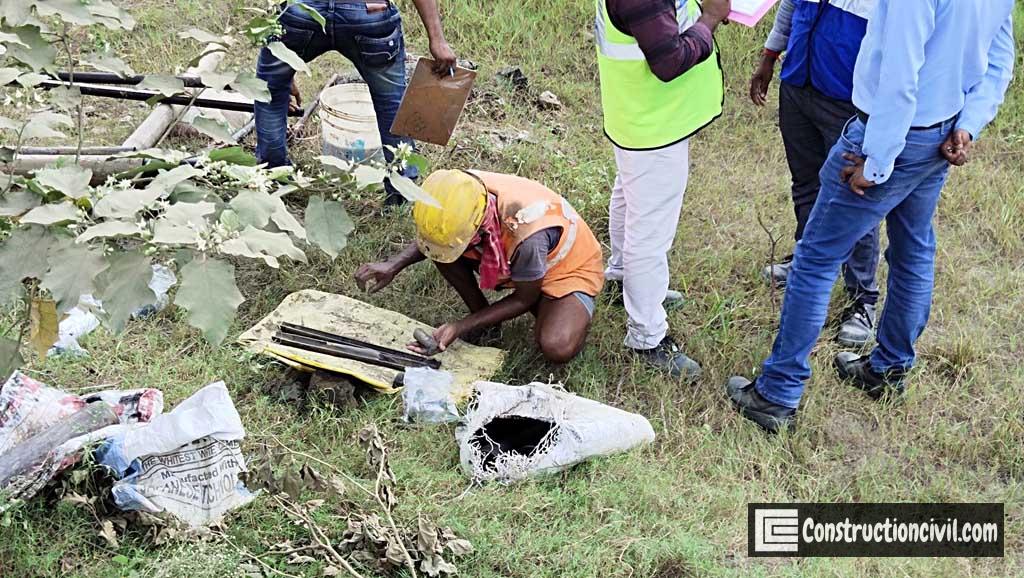
Also, Read: PVD Drain Installation for Ground Improvement
Wash boring Method of Soil Exploration:
Wash boring is a fast and easy method of soil exploration for advancing holes in all soil types. Hard soil strata, like rock, cannot be penetrated by this method. The Wash boring consists of casing driving first and then inserting a hollow drill rod with a sharp chisel or chopping bit at the lower end.
- The Wash boring method is generally used for soil exploration below the groundwater table, for which the auger method of soil exploration is not suitable.
- The above methods of soil exploration can be used in all kinds of soils without those mixed with gravel and boulders.
- A casing pipe is driven in and driven with a drop weight.
- A hollow drill bit is screwed into a hollow drill rod attached to a rope crossing over a pulley and held by a tripod.
- A water jet with pressure is applied through the rod and drilled bit into the hole, which loosens the soil at the deeper end and forces the soil-water suspension upwards along with the annular covering.
- This suspension is directed to the settling tank, where the soil particles settle while the water drains into a sump. The water collected in the sump is reused for circulation next time.
- The soil particles collected represent a very ‘disturbed sample’ and are not very useful for evaluating the engineering properties of soil.
- Wash borings techniques are primarily used for advancing boreholes; whenever a soil sample is needed, the chopping bit is to be substituted by a sampler.
- The change in the rate of progress and evolution of the colour of wash water show changes in soil strata.
Rotary Drilling Method of Soil Exploration:
The rotary drilling method of soil exploration is used to form a deep observation borehole or obtain representative rock samples. The rotary drilling method involves a powered driven rotary cutting edge on the end of the shaft, driven into the ground when it rotates.
- It can be used in sand, clay and rock strata unless badly fissured.
- A drill bit is fixed to the deeper end of a drill rod, which is rotated by power while kept in firm touch with the hole.
- Drilling fluid or bentonite suspension is forced with pressure through the drill rod, and it comes upbringing the cutting soil to the surface.
- Even rock cores may be achieved by using suitable diamond cutter drill bits.
- The drilling rod raises when soil samples are required, and a sampler replaces the drilling bit.
Also, Read: Major Role of Ground Improvement in The Structure Foundations
Percussion Drilling Method of Soil Exploration:
Percussion drilling involves lifting and dropping heavy tools to break rock and uses steel casing tubes to protect the borehole from collapsing. The percussion drilling method of soil exploration is performed by breaking up the soil formation by repeated blows of massive drill bitts or a chisel inside the casing pipe.
- A heavy-duty drill bitts suspended from a drilling rod or a cable and is driven by repeated blows, where a water jet is added to facilitate the separating of hard soil or rock strata.
- The slurry containing cutting material is bailed out at interims.
- The method of soil exploration cannot be used in unconfined sand and is slow in plastic clay.
- The formation gets severely disturbed by the impact.
Soil Exploration for Construction – Indirect Method:
The indirect method of soil exploration includes sounding and penetration tests, which can be static or dynamic cone penetration tests. Geophysical soil investigation methods are simple, quick and physical, making them environment friendly and economical.
- The indirect methods of soil exploration do not give details regarding the engineering properties of the soil. They should be used with direct methods such as boring and percussion drilling.
